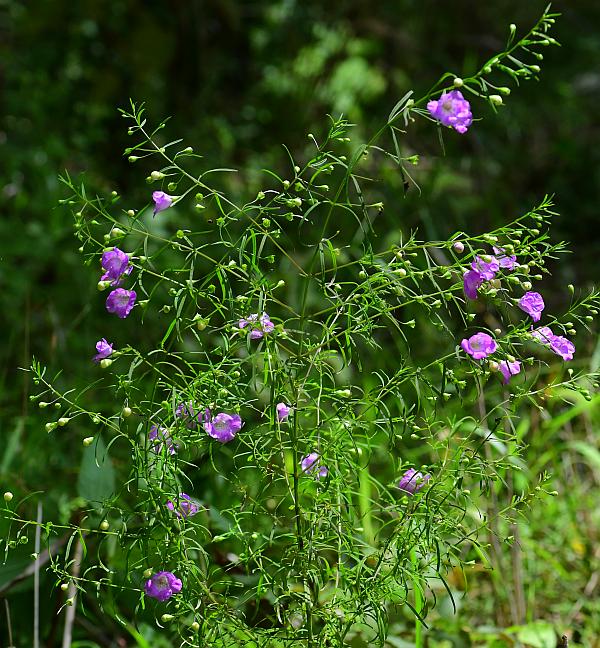Agalinis tenuifolia (Vahl) Raf.
Common Gerardia

Native
CC = 4
CW = 0
MOC = 85
© SRTurner
Agalinis tenuifolia (Vahl) Raf.Common Gerardia | |
 |
Native CC = 4 CW = 0 MOC = 85 |
© SRTurner |
|
Family - Orobanchaceae Habit - Annual hemiparasitic forb. Stems - To 80 cm, extensively branched and bushy, 4-angled, glabrous or roughened along angles. Foliage sometimes with a purplish tinged and often blackening on drying.
Leaves - Opposite, mostly lacking fascicles of leaves or these short and poorly developed. Leaf blades loosely ascending to spreading or arched to curled outward, 10-50 mm long, 1-3 mm wide, threadlike to linear, entire, the upper surface moderately roughened, the undersurface sometimes roughened along the midvein.
Inflorescences - Narrow racemes, the flower stalks 6-25 mm long at flowering, noticeably longer than the calyces, elongating to 15-30 mm at fruiting, slender, more or less straight and ascending to spreading or sometimes curved upward toward the tip.
Flowers - Calyces 3.0-5.5 mm long, broadly bell-shaped to hemispheric, the lobes 0.3-2.0 mm long, much shorter than the tube, relatively thick and triangular, glabrous or sparsely short-hairy on the inner surface and margin, the sinuses between the lobes broadly U-shaped. Corollas 10-16 mm long, pink to more commonly purplish pink, the tube moderately to densely short-hairy externally, the throat with a pair of longitudinal, pale yellow lines and darker, reddish purple spots, glabrous, the lobes glabrous or sparsely to moderately and minutely hairy on the outer surface, short-hairy along the margins, the upper 2 lobes straight or somewhat incurved to slightly arched over the stamens. Anthers 1.0-2.3 mm long.
Fruits - Globose, glabrous, 3-7 mm long. Seeds 0.7-1.0 mm long, tan to dark brown.
Flowering - August - October. Habitat - Dry, moist, or open woods, bluff ledges, prairies, wet depressions, swampy meadows, borders of standing water, wet thickets. Origin - Native to the U.S. Lookalikes - Several other members of the genus, especially A. gattingeri, A. purpurea, and others. Other info. - This small but attractive species can be found throughout Missouri, and is easily the most common and widespread member of the genus in the state. Beyond Missouri it is found throughout most of the eastern U.S. and as far west as Colorado and Wyoming. The plant can be identified by its thin, branching stems, its opposite, linear leaves, its long, thin pedicels, and its characteristic pink flowers. The foliage is often dark green to purplish, though this character is variable. The corolla throats are glabrous (though the stamen filaments are hairy). The upper lip of the flower arches over the stamens and encloses them. Under favorable conditions the plants can become quite bushy, with numerous flowers. Photographs taken off Lee Rd 54, Lee County, AL., 10-2-04 (DETenaglia); also at Shaw Nature Reserve, Franklin County, MO, 9-2-2006 and 9-15-2021, Matson Hill County Park, St. Charles County, MO, 8-29-2021, Don Robinson State Park, Jefferson County, MO, 9-19-2021, and at Klondike County Park, St. Charles County, MO, 10-10-2021 (SRTurner). |